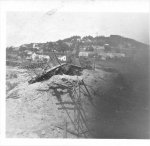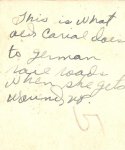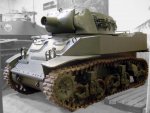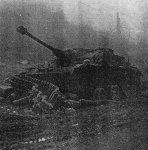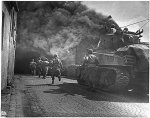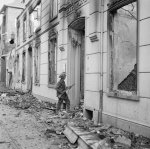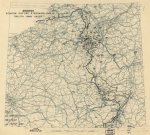Looks to me like the USAAF hates German crops in the fields.December 2, 1944: ... German rail yard after Allied bombing raid, December 2, 1944.;
View attachment 5038
75th anniversary of D-Day...
- Thread starter crimsonaudio
- Start date
- Status
- Not open for further replies.
Unfortunately too much of that...Looks to me like the USAAF hates German crops in the fields.
I do not know the details, but the physics of bombing are tough. Plus, crosswinds, errors in elevation, hitting anything smaller than a city was an achievement.Unfortunately too much of that...
The M102, 155mm HE round contained 15 lbs, 9 oz. of TNT. That picture shows a lot of damage for 16 lbs of TNT. I wonder if that damage might have been done by a 250 lb or 500 lb bomb from an airplane and the photographer just believed arty had done that.It had me recall this photo of German railroad tracks and the note on the back. The 155 mm had been named Carial?
View attachment 5041
I've been downrange with a 155mm round goes off (inside a solid bunker) and, while it is a big boom, it was no so big that it could do that to a railroad.
December 3, 1944: In the bloody battle for the Hurtgen, the 8th Infantry Regiment of 4th Infantry Division endures extremely heavy concentrations of artillery fire just prior to the scheduled time of the attack and it becomes apparent that the Germans have also planned an attack. Numerous skirmishes take place preventing the 8th ID from gaining much ground so they are ordered to consolidate their current positions and to work on mopping up the German forces that have infiltrated their right flank.
The 12th Infantry remains on the defense throughout the day. Early in the morning it is reported that the Germans are infiltrating around the west flank of Company B and have caused the withdrawal of Company G. The lost ground is regained with the support of one platoon of Company L. Numerous prisoners of war are taken during the day.
The 22nd Infantry remains in its defensive positions until just before noon, when elements of the 330th Infantry Regiment (83rd Infantry Division) begin to relieve them. In the interim, the 1st Battalion successfully repulses a counterattack which had been launched earlier in the morning. By nightfall, 22nd Infantry has been relieved and the regiment moves to its new assembly area.
US 9th Army continues attacking strongpoints around Juelich and US 1st Army is attacking around Lucherberg, Luchem, Brandenberg, and Vossenack. US 3rd Army armored units penetrate the German Westwall defenses near Saarlautern, and continue fighting around Creutzwald, Lauterbach, and Sarre-Union. Elements of the US 20th Corps (part of US 3rd Army) cross the Saar River near Patchen, in assault boats and secure the main bridge of the Saar. US 7th Army attacks around Ratzwiller, Zinswiller, .....e, and Selestat
Allied troops captured Blerick, the Netherlands, and the British 2nd Army mopped up the last German resistance west of the River Maas.
On the eastern front, troops from the Soviet 2nd Ukrainian Front capture Miskolc.
In Italy British, Canadian and Polish forces of British 8th Army begin new attacks on a broad, 3 corps frontage, moving toward Bologna while US 12th Air Force supports ground operations and attacks limited targets in northern Italy in poor weather conditions.
Pictured: US Sherman tank in the Hurtgen, early December, 1944.; US troops use a bazooka to defeat a Panther tank, December 3, 1944.; 90th Infantry Division mortar crew fires high explosive (HE) shells into fortified German positions along the Moselle River, near Halstroff, France – December 3, 1944.; US troops move in northern Italy, early December, 1944.

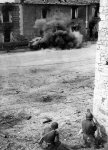
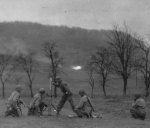
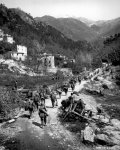
The 12th Infantry remains on the defense throughout the day. Early in the morning it is reported that the Germans are infiltrating around the west flank of Company B and have caused the withdrawal of Company G. The lost ground is regained with the support of one platoon of Company L. Numerous prisoners of war are taken during the day.
The 22nd Infantry remains in its defensive positions until just before noon, when elements of the 330th Infantry Regiment (83rd Infantry Division) begin to relieve them. In the interim, the 1st Battalion successfully repulses a counterattack which had been launched earlier in the morning. By nightfall, 22nd Infantry has been relieved and the regiment moves to its new assembly area.
US 9th Army continues attacking strongpoints around Juelich and US 1st Army is attacking around Lucherberg, Luchem, Brandenberg, and Vossenack. US 3rd Army armored units penetrate the German Westwall defenses near Saarlautern, and continue fighting around Creutzwald, Lauterbach, and Sarre-Union. Elements of the US 20th Corps (part of US 3rd Army) cross the Saar River near Patchen, in assault boats and secure the main bridge of the Saar. US 7th Army attacks around Ratzwiller, Zinswiller, .....e, and Selestat
Allied troops captured Blerick, the Netherlands, and the British 2nd Army mopped up the last German resistance west of the River Maas.
On the eastern front, troops from the Soviet 2nd Ukrainian Front capture Miskolc.
In Italy British, Canadian and Polish forces of British 8th Army begin new attacks on a broad, 3 corps frontage, moving toward Bologna while US 12th Air Force supports ground operations and attacks limited targets in northern Italy in poor weather conditions.
Pictured: US Sherman tank in the Hurtgen, early December, 1944.; US troops use a bazooka to defeat a Panther tank, December 3, 1944.; 90th Infantry Division mortar crew fires high explosive (HE) shells into fortified German positions along the Moselle River, near Halstroff, France – December 3, 1944.; US troops move in northern Italy, early December, 1944.




My Dad took the photo and wrote the note on the back. I would assume that an entire battery would be firing at a specific target that was called in by spotters to the battery command. It is impossible to know any more of the specifics although if a battery was in the field they would likely know to what degree of bombing took place within the 12 -15 mile range involved. Anyway it sure tore the heck out of those tracks.The M102, 155mm HE round contained 15 lbs, 9 oz. of TNT. That picture shows a lot of damage for 16 lbs of TNT. I wonder if that damage might have been done by a 250 lb or 500 lb bomb from an airplane and the photographer just believed arty had done that.
I've been downrange with a 155mm round goes off (inside a solid bunker) and, while it is a big boom, it was no so big that it could do that to a railroad.
Last edited:
December 4, 1944: The muddy, bloody battle for the Hurtgen continues. US 9th Army suspends offensive operations toward the Roer River except around Juelich whil eUS 1st Army continues attacking around Brandenberg-Bergstein ridge and Vossenack. The US 3rd Army forces of US 20th Corps concentrates forces for the capture of Saarlautern, where reconnaissance indicates there is an intact bridge over the Saar River. 3rd Army continues attacking around Fraulautern, Lisdorf, Farebersviller, Puttelange, Sarre-Union, and Domfessel. The US 7th Army completes capture of Selestat. US 7th Army completes capture of Selestat. Elements of British 2nd Army clear the last pockets of German resistance west of the Maas River.
4th Infantry Division’s 8th Infantry Regiment attacks to the south with elements of the 1st and 2nd Battalions in an effort to clear pockets of German resistance between their current positions and the right boundary of the regiment. They make contact with the Germans just before noon and a small arms fire fight ensues. The attack progresses and the enemy pocket is successfully destroyed, after which the attacking units return to positions formerly held and the new cleared area is watched carefully by the 24th Cavalry Reconnaissance Squadron.
The 12th Infantry launches an attack with the 3rd Battalion to the northeast to clear pockets of resistance between its positions and the left boundary of the regiment. By mid-afternoon the objectives have been reached, so the the battalion withdraws and the terrain covered during the fight is also watched by the 24th Cav Sqn. The 22nd Infantry begins moving mid-morning, passing Zweifall on the way to a new assembly area in the vicinity of Luxembourg.
Above Germany, US 8th Air Force attacks Kassel and Soest with 189 bombers, Bebra with 199 bombers, Giessen and Koblenz with 161 bombers, Mainz with 221 bombers, Friedburg with 119 bombers, and targets of opportunity with 41 bombers. RAF Bomber Command sends 160 aircraft to attack Oberhausen during the day, 30 aircraft to attack Urft dam during the day, 535 aircraft to attack Karlsruhe overnight, 292 aircraft to attack Heilbronn overnight, and 54 aircraft to attack Hagen overnight.
On the eastern front, the 46th Army of Soviet 3rd Ukrainian Front unsuccessfully attacks across the Danube around Ercsi.
In Italy, the British 8th Army captures Montecchio and Ravenna, US 5th Army captures most of Monte Penzola, and US 12th Air Force supports ground operations and attacks targets in northern Italy.
Pictured: American GIs monitoring a German radio line, December 4, 1944.; Aircrew and ground crew of No. 428 (Ghost) Squadron, RAF, with Avro Lancaster B.X aircraft KB760 NA "P-Peter”.; M10 tank destroyer crew plays craps while waiting for a road block to be removed, December 4, 1944.; Infantry of the 1st Suffolk Regiment rest during a patrol east of the Maas near Geijsteren, December 4, 1944.
"P-Peter”.; M10 tank destroyer crew plays craps while waiting for a road block to be removed, December 4, 1944.; Infantry of the 1st Suffolk Regiment rest during a patrol east of the Maas near Geijsteren, December 4, 1944.
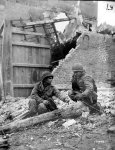
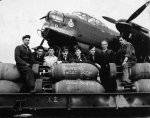
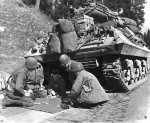
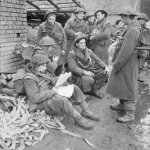
4th Infantry Division’s 8th Infantry Regiment attacks to the south with elements of the 1st and 2nd Battalions in an effort to clear pockets of German resistance between their current positions and the right boundary of the regiment. They make contact with the Germans just before noon and a small arms fire fight ensues. The attack progresses and the enemy pocket is successfully destroyed, after which the attacking units return to positions formerly held and the new cleared area is watched carefully by the 24th Cavalry Reconnaissance Squadron.
The 12th Infantry launches an attack with the 3rd Battalion to the northeast to clear pockets of resistance between its positions and the left boundary of the regiment. By mid-afternoon the objectives have been reached, so the the battalion withdraws and the terrain covered during the fight is also watched by the 24th Cav Sqn. The 22nd Infantry begins moving mid-morning, passing Zweifall on the way to a new assembly area in the vicinity of Luxembourg.
Above Germany, US 8th Air Force attacks Kassel and Soest with 189 bombers, Bebra with 199 bombers, Giessen and Koblenz with 161 bombers, Mainz with 221 bombers, Friedburg with 119 bombers, and targets of opportunity with 41 bombers. RAF Bomber Command sends 160 aircraft to attack Oberhausen during the day, 30 aircraft to attack Urft dam during the day, 535 aircraft to attack Karlsruhe overnight, 292 aircraft to attack Heilbronn overnight, and 54 aircraft to attack Hagen overnight.
On the eastern front, the 46th Army of Soviet 3rd Ukrainian Front unsuccessfully attacks across the Danube around Ercsi.
In Italy, the British 8th Army captures Montecchio and Ravenna, US 5th Army captures most of Monte Penzola, and US 12th Air Force supports ground operations and attacks targets in northern Italy.
Pictured: American GIs monitoring a German radio line, December 4, 1944.; Aircrew and ground crew of No. 428 (Ghost) Squadron, RAF, with Avro Lancaster B.X aircraft KB760 NA




I was intrigued by the GIs monitoring a German line. There's not a lot written about it but we depended heavily in Europe on soldiers of Jewish descent who grew up hearing Yiddish at home. The gap between Yiddish and German is not really that great. I understand almost all of it. The soldier listening in may well be Jewish. One interesting incident with regard to that played into "Operation Paperclip." My former German/Nazi/physicist neighbor told me that, when von Braun led them to the American side, the GIs who came to talk to them about surrender had strong Jewish accents. He said that there was no way they would surrender to Jews. (I'm sure out of fear.) The Army found German-speaking interpreters who had no Jewish accent to come speak to them and the surrender was accomplished. Years later, he needed a piece of legal work done and I was about to leave town. I told him that my partner could handle it. He was reluctant to go to George, who was Jewish. He said "You know, the Germans have done so much to the Jews." He did, however, go on to see George. We were living next door to each other at the time of the '67 Israel/Arab war. He was mightily impressed with the Israelis. He said "See, just as good as any storm trooper." He had been so thoroughly indoctrinated with the Nazi trash about Jews being docile and non-fighters, that he was surprised at their bravery and efficiency. Not having grown up with that, I was not surprised at all...
December 5, 1944: It’s Tuesday - today is D+182, marking 26 weeks (182 days) since the D-Day Invasion at Normandy and the beginning of the liberation of Europe.
The Germans remain on the defensive, seemingly content on harassing 4th Infantry Division’s front lines with heavy artillery and mortar fire. The 8th Infantry consolidates its front line positions and maintains contact with the 4th Cavalry Reconnaissance Squadron on its left (north) flank and the 24th Cavalry Reconnaissance Squadron on its right.
The 12th Infantry adjusts its positions and prepares for relief. The 22nd Infantry completes its movement to the new division area of action and comes under control of the 83rd Infantry Division.
The CT 330 Infantry Regiment improves its front line positions. A counterattack by an estimated 47 enemy infantry is launched shortly after first light (following a heavy mortar and artillery preparation) has been repulsed after inflicting heavy German casualties and a total of 20 prisoners of war were taken.
US 9th Army continues attacking toward Juelich while US 1st Army remains heavily engaged driving through the Hurtgen Forest. US 7th Army pushing toward Strasbourg and St Die while the US 3rd Army still fighting in Metz. German 19th Army counterattacks French 1st Army around Suarce and Lepuix. British 2nd Army attacking toward Venlo but suspends operations in Geilenkirchen-Linnich sector. On Franco-Italian border, US 44th AA Brigade relieves 1st Airborne Task Force in coastal sector.
Over Germany, the Allies take advantage of clear weather to hammer Germany. The US 8th Air Force attacks Merseburg with 200 bombers,Hamburg with 349 bombers,Osnabruk with 166 bombers, and targets of opportunity with 422 bombers. The Luftwaffe loses 86 fighters in daylight operations defending against the 8th Air Force bombing runs. RAF Bomber Command sends 160 aircraft to attack Homberg during the day escorted by Fighter Command, then send a out the night-time raids: 283 aircraft to attack Aschaffenburg, 273 aircraft to attack Castrop-Rauxel, 270 aircraft to attack Sterkrade, 138 aircraft to attack the Mittellland canal, 123 aircraft to attack the Dortmund-Ems canal, 29 aircraft to attack Stuttgart, 26 aircraft to attack Hannover, and 19 aircraft to attack Worms.
On the eastern front, the Soviet 2nd Ukrainian Front continues attacking around Ercsi and Vac. The 57th Army of Soviet 3rd Ukrainian Front captures Szigetvar and the 37th Army of Soviet 3rd Ukrainian Front captures Vukovar.
In Italy, the British 8th Army opens new attacks toward Faenza while troops of Canadian 1st Corps (part of British 8th Army) capture Ravenna. US 12th Air Force aircraft continue to pound transportation targets in the Po valley and at the Brenner Pass.
Pictured: German armor knocked out by US artillery in the Hurtgen, early December, 1944.; US troops advance into Germany, hopes that the war would be over by Christmas all but gone.; A soldier of 6th King’s Own Scottish Borderers, 15th (Scottish) Division, searches wrecked buildings in Blerick, a suburb of Venlo in Holland, December 5, 1944.; 12th Army situation map from December 5, 1944
The Germans remain on the defensive, seemingly content on harassing 4th Infantry Division’s front lines with heavy artillery and mortar fire. The 8th Infantry consolidates its front line positions and maintains contact with the 4th Cavalry Reconnaissance Squadron on its left (north) flank and the 24th Cavalry Reconnaissance Squadron on its right.
The 12th Infantry adjusts its positions and prepares for relief. The 22nd Infantry completes its movement to the new division area of action and comes under control of the 83rd Infantry Division.
The CT 330 Infantry Regiment improves its front line positions. A counterattack by an estimated 47 enemy infantry is launched shortly after first light (following a heavy mortar and artillery preparation) has been repulsed after inflicting heavy German casualties and a total of 20 prisoners of war were taken.
US 9th Army continues attacking toward Juelich while US 1st Army remains heavily engaged driving through the Hurtgen Forest. US 7th Army pushing toward Strasbourg and St Die while the US 3rd Army still fighting in Metz. German 19th Army counterattacks French 1st Army around Suarce and Lepuix. British 2nd Army attacking toward Venlo but suspends operations in Geilenkirchen-Linnich sector. On Franco-Italian border, US 44th AA Brigade relieves 1st Airborne Task Force in coastal sector.
Over Germany, the Allies take advantage of clear weather to hammer Germany. The US 8th Air Force attacks Merseburg with 200 bombers,Hamburg with 349 bombers,Osnabruk with 166 bombers, and targets of opportunity with 422 bombers. The Luftwaffe loses 86 fighters in daylight operations defending against the 8th Air Force bombing runs. RAF Bomber Command sends 160 aircraft to attack Homberg during the day escorted by Fighter Command, then send a out the night-time raids: 283 aircraft to attack Aschaffenburg, 273 aircraft to attack Castrop-Rauxel, 270 aircraft to attack Sterkrade, 138 aircraft to attack the Mittellland canal, 123 aircraft to attack the Dortmund-Ems canal, 29 aircraft to attack Stuttgart, 26 aircraft to attack Hannover, and 19 aircraft to attack Worms.
On the eastern front, the Soviet 2nd Ukrainian Front continues attacking around Ercsi and Vac. The 57th Army of Soviet 3rd Ukrainian Front captures Szigetvar and the 37th Army of Soviet 3rd Ukrainian Front captures Vukovar.
In Italy, the British 8th Army opens new attacks toward Faenza while troops of Canadian 1st Corps (part of British 8th Army) capture Ravenna. US 12th Air Force aircraft continue to pound transportation targets in the Po valley and at the Brenner Pass.
Pictured: German armor knocked out by US artillery in the Hurtgen, early December, 1944.; US troops advance into Germany, hopes that the war would be over by Christmas all but gone.; A soldier of 6th King’s Own Scottish Borderers, 15th (Scottish) Division, searches wrecked buildings in Blerick, a suburb of Venlo in Holland, December 5, 1944.; 12th Army situation map from December 5, 1944
Attachments
-
344.9 KB Views: 8
-
105.6 KB Views: 6
-
138.4 KB Views: 10
-
623.2 KB Views: 10
That and the Israelis were facing Arabs.
Arabs, in many individual cases, fight bravely, but culturally have a tough time synchronizing ops across multiple units.
Arabs, in many individual cases, fight bravely, but culturally have a tough time synchronizing ops across multiple units.
I thought it would be strange to give a Anti-Aircraft ARtillery Brigae a defensive sector all its own.
Here is nmore about the 44th AAA Brigade.
"3A. The 44th AAA Brigade is established as a separate Command directly under this Headquarters (6th Army Group). Effective 1200A hours 15th November 1944 Headquarters 44 AAA Brigade, augmented, will assume command of the sector currently assigned to the First Airborne Task Force (Alpes Maritime).
"3B. The 44th AAA Brigade will protect right (East) flank along Franco-Italian border south of line Alps-St. Etienne de Tinee-Cuneo all inclusive. Establish contact patrols with First French Army elements on the north."
… The final disposition of the infantry elements of the Task Force on the M.L.R.[Main Line of Resistance] —actually a series of strong points covering the passes—was as follows: the 442d Regimental Combat Team, less three Companies used as a mobile reserve, held the southern and most active sector with its right (East) flank resting on the Mediterranean and supported by the 552d Infantry Anti-Tank Company. Then came in succession from right to left the 65th (Puerto Rican) Infantry, the 899th AAA AW Battalion (converted to infantry)' and finally on the extreme left (North) flank eight F.F.I. (French Forces of the Interior) battalions. These latter troops were composed entirely of former members of the French Resistance. At this time the French were making an effort to incorporate them into the regular French Army.. They were a tough, casehardened lot with many of the characteristics of the Foreign Legion. Assigned the quietest part of the line, which was also the wildest and most mountainous, they suffered considerable hardship due to a serious shortage of food, clothing and equipment. Once they learned that trying to hijack jeeps from American soldiers did not payoff, they settled down and became excellent mountain troops."
Coast Artillery Journal, May-June 1948, p. 7 and 49.
Here is nmore about the 44th AAA Brigade.
"3A. The 44th AAA Brigade is established as a separate Command directly under this Headquarters (6th Army Group). Effective 1200A hours 15th November 1944 Headquarters 44 AAA Brigade, augmented, will assume command of the sector currently assigned to the First Airborne Task Force (Alpes Maritime).
"3B. The 44th AAA Brigade will protect right (East) flank along Franco-Italian border south of line Alps-St. Etienne de Tinee-Cuneo all inclusive. Establish contact patrols with First French Army elements on the north."
… The final disposition of the infantry elements of the Task Force on the M.L.R.[Main Line of Resistance] —actually a series of strong points covering the passes—was as follows: the 442d Regimental Combat Team, less three Companies used as a mobile reserve, held the southern and most active sector with its right (East) flank resting on the Mediterranean and supported by the 552d Infantry Anti-Tank Company. Then came in succession from right to left the 65th (Puerto Rican) Infantry, the 899th AAA AW Battalion (converted to infantry)' and finally on the extreme left (North) flank eight F.F.I. (French Forces of the Interior) battalions. These latter troops were composed entirely of former members of the French Resistance. At this time the French were making an effort to incorporate them into the regular French Army.. They were a tough, casehardened lot with many of the characteristics of the Foreign Legion. Assigned the quietest part of the line, which was also the wildest and most mountainous, they suffered considerable hardship due to a serious shortage of food, clothing and equipment. Once they learned that trying to hijack jeeps from American soldiers did not payoff, they settled down and became excellent mountain troops."
Coast Artillery Journal, May-June 1948, p. 7 and 49.
Last edited:
If you want to know how the intel folks (S-2 staff section) had produced such detailed maps of the enemy situation (for example, the 5 Dec 44 situation map above), here is how they did it:
Generally speaking the fighting was confined to getting aggressive patrols or raiding parties into enemy territory and keeping them out of ours. In this we were most successful, with prisoners-German being almost automatically provided by our patrols on S-2 demand. A total of eighty-nine were taken, for intelligence purposes, against a total loss of two Americans. The inability of the enemy to get information kept them jittery. On one occasion they staged an eighty-man-commando trained-raid against a twelve-man outpost of the 442d R.C.T. A bitter fight developed 'with the Germans finally bolting leaving thirty dead and fifteen prisoners. We suffered no casualties and lost no prisoners to the enemy. Similar isolated actions were almost a daily occurrence and were typical of the fighting throughout the sector. ibid., p. 50.
Generally speaking the fighting was confined to getting aggressive patrols or raiding parties into enemy territory and keeping them out of ours. In this we were most successful, with prisoners-German being almost automatically provided by our patrols on S-2 demand. A total of eighty-nine were taken, for intelligence purposes, against a total loss of two Americans. The inability of the enemy to get information kept them jittery. On one occasion they staged an eighty-man-commando trained-raid against a twelve-man outpost of the 442d R.C.T. A bitter fight developed 'with the Germans finally bolting leaving thirty dead and fifteen prisoners. We suffered no casualties and lost no prisoners to the enemy. Similar isolated actions were almost a daily occurrence and were typical of the fighting throughout the sector. ibid., p. 50.
Last edited:
Very interesting. To what do you attribute our superiority at patrolling? Green troops on their side?If you want to know how the intel folks (S-2 staff section) had produced such detailed maps of the enemy situation, here is how they did it:
Generally speaking the fighting was confined to getting aggressive patrols or raiding parties into enemy territory and keeping them out of ours. In this we were most successful, with prisoners-German being almost automatically provided by our patrols on S-2 demand. A total of eighty-nine were taken, for intelligence purposes, against a total loss of two Americans. The inability of the enemy to get information kept them jittery. On o~e occasion they staged an eighty-man-commando trained-raid against a twelve-man outpost of the 442d R.C.T. A bitter fight developed 'with the Germans finally bolting leaving thirty dead and fifteen prisoners. We suffered no casualties and lost no prisoners to the enemy. Similar isolated actions were almost a daily occurrence and were typical of the fighting throughout the sector. ibid., p. 50.
If the U.S. forces were superior at patrolling, I would attribute it to two factors: extreme youth (and extreme age) on the part of the Wehrmacht units on the other side. Extremely young soldiers (I saw the grave of a 17 year old in the German cemetery outside the Belgian village of Foy) means making rookie mistakes. The extremely old (and by this time, the Germans were conscripting 50 year olds) have a tough time holding up in the mountainous terrain and just the rigors of infantry combat.
American troops tended to be not too young and not too old.
The difference between good infantry and poor infantry is narrower than many think. When leaders who do not understand that want to tinker with the army, they are taking a great risk.
In this particular instance (in the Maritime Alps), the 442nd R.C.T. was just being stubborn, like usual. They had something to prove.
American troops tended to be not too young and not too old.
The difference between good infantry and poor infantry is narrower than many think. When leaders who do not understand that want to tinker with the army, they are taking a great risk.
In this particular instance (in the Maritime Alps), the 442nd R.C.T. was just being stubborn, like usual. They had something to prove.
By "green," I was Thinking specifically of the pix of the youth and oldsters marching in civvies with dummy guns. OTOH, Roman soldiers had an obligation of 25 years or 16 campaigns. With a life expectancy of early-mid 40s, that was essentially a lifetime commitment. They weren't even allowed to marry until around 200 AD...
Gotcha.By "green," I was Thinking specifically of the pix of the youth and oldsters marching in civvies with dummy guns. OTOH, Roman soldiers had an obligation of 25 years or 16 campaigns. With a life expectancy of early-mid 40s, that was essentially a lifetime commitment. They weren't even allowed to marry until around 200 AD...
A German man who was 50 in 1944 had been 20 in 1914, so the 50 year olds likely had some prior combat (WW I) experience, so many had worn a uniform, marched long distances, lived in the field, and been in a firefight. Heck a 45 year old German probably had some combat experience, plus, in some cases, experience in WW II.
The age issue, however, is tough to get around. Even if experienced, the Maritime Alps are hard on 50+ year old men.
- Status
- Not open for further replies.
Latest threads
-
-
-
SIAP there was an article that Joe K interviewed for assistant coach
- Started by mlingerfelt31
- Replies: 11
-
Final Home Midweek for Alabama Brings Samford to The Joe
- Started by Diamond Tide
- Replies: 0
-
-


